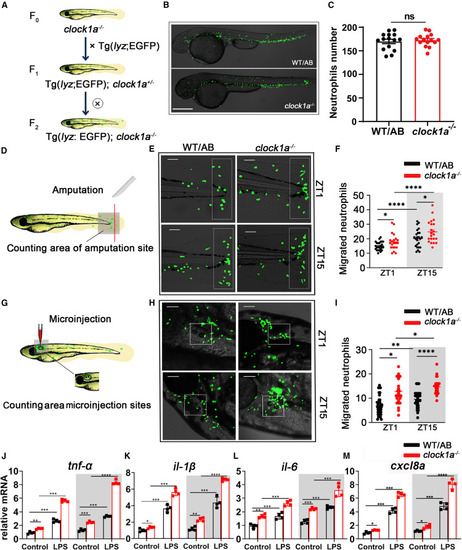Fig. 3
- ID
- ZDB-FIG-240205-33
- Publication
- Chen et al., 2023 - Circadian clock1a coordinates neutrophil recruitment via nfe212a/duox-reactive oxygen species pathway in zebrafish
- Other Figures
- All Figure Page
- Back to All Figure Page
|
Clock1a regulates the rhythmic migration of neutrophils to inflamed tissue (A) Hybridization of the transgenic line Tg(lyz:EGFP) and clock1a mutant was performed for two consecutive generations to obtain the Tg(lyz:EGFP);clock1a−/− line. (B and C) The total number of fluorescently labeled neutrophils in WT and clock1a−/− larvae showed no significant difference (n = 15, each group). Scale bar: 50 μm. Data were analyzed with unpaired t tests. (D) Schematic of larval (5 dpf) tail fin injury with a surgical blade at the end of the spinal cord at ZT1 and ZT15. (E and F) In WT zebrafish, neutrophil migration toward the injury was rhythmic, and Tg(lyz:EGFP);clock1a−/− larvae showed increased neutrophil migration at both ZT1 and ZT15 (n = 25, each group). Scale bar: 5 μm. Data were analyzed with one-way ANOVA. (G) Schematic of LPS microinjection into otic vesicles in vivo at ZT1 and ZT15. (H and I) In WT zebrafish, neutrophil migration toward LPS was rhythmic, and Tg(lyz:EGFP);clock1a−/− larvae showed increased neutrophil migration at both ZT1 and ZT15 (n = 25, each group). Scale bar: 5 μm. Data were analyzed with one-way ANOVA. Scale bar: 4 μm. (J–M) Under homeostasis, the mRNA expression of the cytokines tnf-α, il-1β, il-6, and cxcl8a showed circadian rhythms, and clock1a mutation significantly upregulated their expression. Under LPS stimulation, the expression of the cytokines tnf-α, il-1β, il-6, and cxcl8a showed circadian rhythms, and clock1a mutation significantly upregulated their expression. Data were analyzed with one-way ANOVA. All experiments were repeated three times, and the results show the data from an independent experiment. Bar graphs represent the mean ± SEM (∗p < 0.05; ∗∗p < 0.01; ∗∗∗p < 0.001). |

